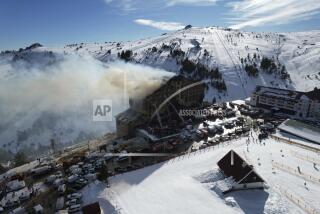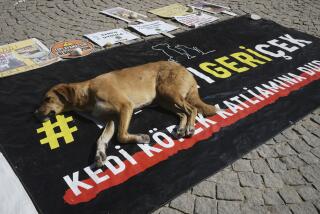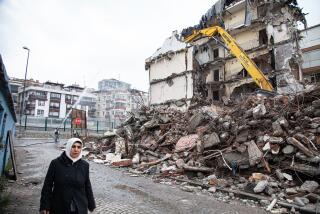Hot Nights Sustain a Perilous Kurd Tradition
- Share via
CARIKLI, Turkey — Believing he was indoors, 4-year-old Murat Ciftci rose during the night, stumbled toward an imaginary bathroom and stepped right off the top of his two-story house.
“I was awakened by this piercing scream followed by a loud thud,” said Ahmet Ciftci, his father. “I looked down, and there was our little Murat curled up on the ground.”
The boy survived the 13-foot plunge with a broken arm and a few cuts. But here in Turkey’s predominantly Kurdish southeast, hundreds of children die in falls each summer because stifling heat drives them and their families to their roofs in search of sleep.
Falling off roofs is the region’s second leading cause of child fatalities, after traffic accidents, says Yusuf Yagmur, a U.S.-trained emergency ward surgeon at Dicle University Hospital in the nearby city of Diyarbakir.
Rooftop sleeping is a custom peculiar to Turkey’s most arid, impoverished region, whose 6 million people became numbed to loss during a 14-year war in which the army defeated a Kurdish separatist movement.
A centuries-old tradition of building homes with flat, thatched roofs makes it possible to take refuge there. And for many, Turkey’s hottest temperatures make it imperative, as does the threat from the poisonous snakes and scorpions that invade their homes.
With temperatures averaging 113 degrees during the day, the flimsy, whitewashed brick shanties with their tiny windows and flat roofs are transformed into “a miniature hell,” Yagmur said. “Even the chief of general staff [of the army] wouldn’t be able to get these people to sleep indoors.”
Judging from a tour of rural villages and urban slums around Diyarbakir, the region’s largest city, as many as four out of five families sleep on the roof.
In interviews, dozens of families said they do so because they lack money for fans or air conditioners. Nor can they afford to install protective walls or rails around their roofs.
“My husband earns 80 million liras [about $125] a month washing cars; we can barely feed ourselves,” Fatma Gunduz, a gaunt mother of seven, said at Diyarbakir’s state hospital. Her 8-year-old son, Sehmuz, had sleepwalked off their roof and was undergoing surgery for a fractured skull.
Despite the fall that injured Murat Ciftci this month, he and his family continue to sleep on their roof in Carikli, a village 12 miles south of Diyarbakir, but they now take precautions. Instead of bedding down on individual mattresses, they all crowd into a contraption that looks like a giant crib.
This local invention is known as a taht, or throne. Dotting thousands of rooftops across the Kurdish provinces, the cagelike structures are designed to prevent their occupants from rolling out of bed and, with 3-foot-high legs, place them beyond reach of scorpions and snakes. At $30 apiece, they cost less than the fans it would take to cool a whole family.
But are they enough?
“Not really,” said Ahmet Bulut, another surgeon at the state hospital’s emergency ward, who noted that children spend much of their waking hours on the roof. Most of the 16 children treated there during the previous 24 hours had fallen off roofs while engaged in horseplay, he said, not in their sleep. Others had tumbled from stairways--often lacking handrails--that lead to the rooftops.
Bulut said the state hospital treats an average of 50 children each summer day for roof-related injuries. “You can safely assume that at least double that many are being treated at other hospitals in the southeast every day,” he said, “and scores of other cases go unreported.”
According to Yagmur, 117 children died in greater Diyarbakir in such accidents in 1997. The average age of victims was 8.
“Unfortunately, the government is doing absolutely nothing to stop these deaths,” the surgeon complained.
He wants local authorities to help pay for protective railings and walls for flat-roofed homes and to make sloped roofs mandatory in new construction.
“This is an absolute fantasy,” scoffs Cezair Serin, mayor of Diyarbakir’s Surici district. He said his budget doesn’t even cover the wages owed public employees.
Serin is one of 32 mayors elected last year from the pro-Kurdish People’s Democracy Party, which favors more autonomy for the region. Like the other mayors, he says the central government in Ankara has failed to send millions of dollars promised to his municipality.
In large cities such as Diyarbakir, most of the flat-roofed houses are illegally built shanties called gecekondus, which translates as “placed overnight.” Such shoddy construction, without the required permit, is widespread in Turkey and was a factor in the deaths of more than 17,000 people in a major earthquake in northwestern Turkey in August.
City officials in Diyarbakir say they are reluctant to require inhabitants to build railings or walls on flat-roofed shanties because that would amount to recognizing their legality.
The problem has been compounded by the forced eviction of millions of Kurdish villagers during the war. Serin said that Diyarbakir’s population has ballooned from 500,000 in the early 1990s to about 1.5 million today.
Many of the displaced villagers live in gecekondus with no running water, sewage or heating. There are as many as 2,000 such homes in Surici, built around Diyarbakir’s ancient fortress walls.
“These people have endured so much brutality and suffering that when you warn them about the danger of sleeping on rooftops,” the mayor said, “they simply stare at you and begin to laugh.”
More to Read
Sign up for Essential California
The most important California stories and recommendations in your inbox every morning.
You may occasionally receive promotional content from the Los Angeles Times.










